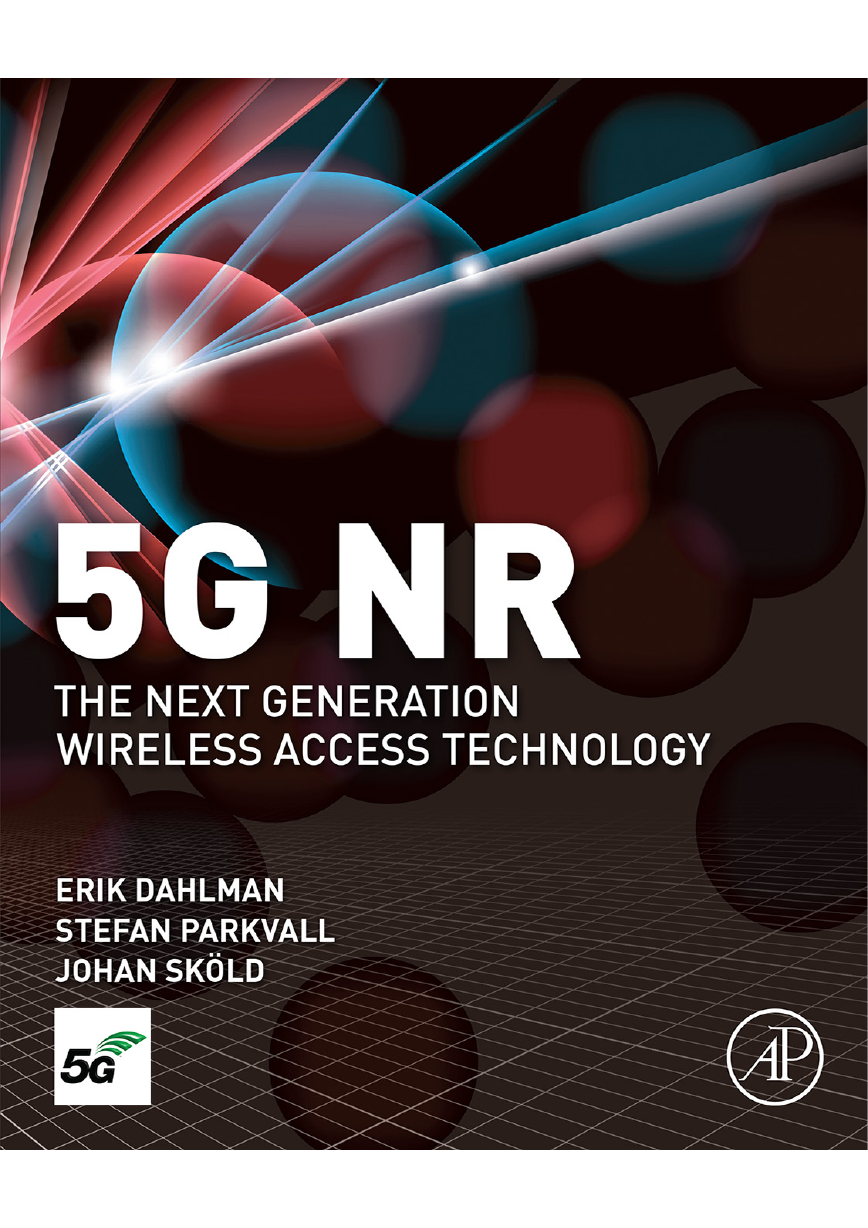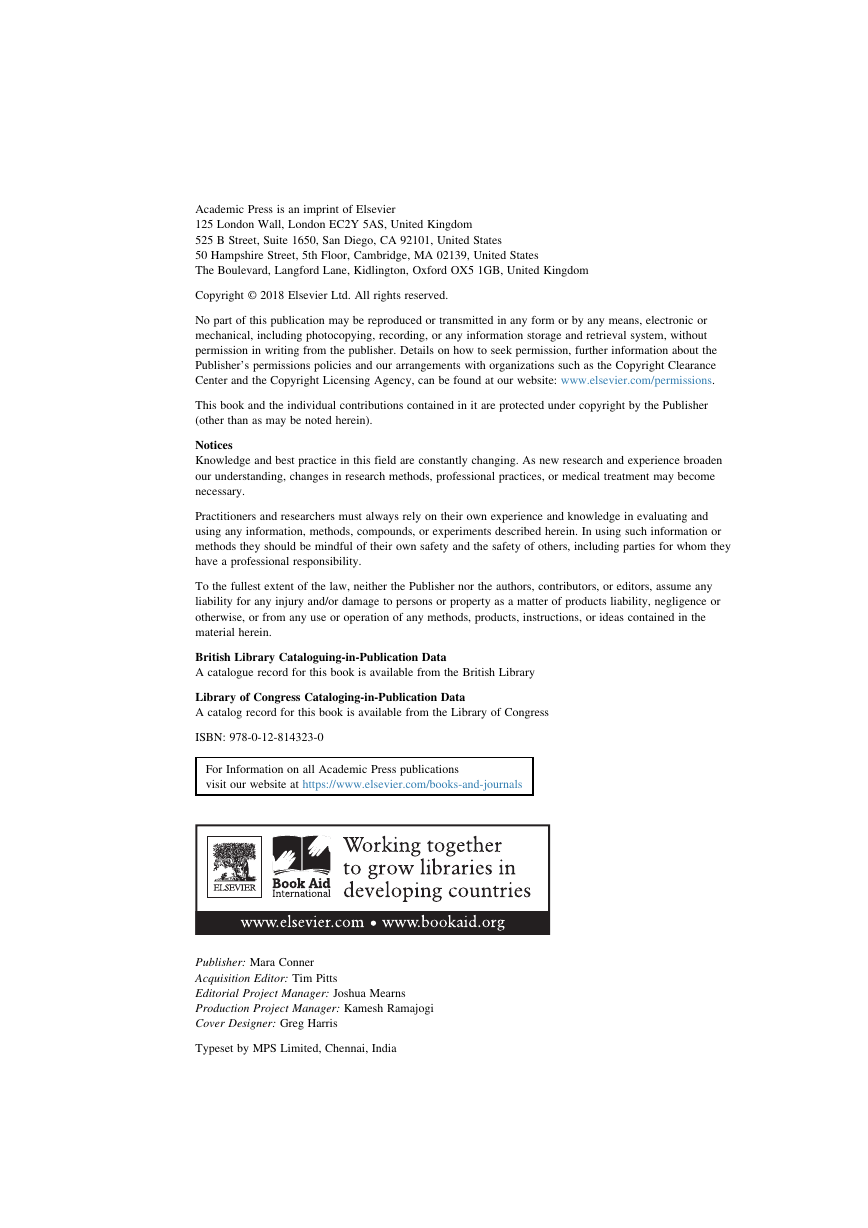�
5G NR: The Next
Generation Wireless
Access Technology
This page intentionally left blank
�
5G NR: The Next
Generation Wireless
Access Technology
Erik Dahlman
Stefan Parkvall
Johan Sko¨ld
�
Academic Press is an imprint of Elsevier
125 London Wall, London EC2Y 5AS, United Kingdom
525 B Street, Suite 1650, San Diego, CA 92101, United States
50 Hampshire Street, 5th Floor, Cambridge, MA 02139, United States
The Boulevard, Langford Lane, Kidlington, Oxford OX5 1GB, United Kingdom
Copyright © 2018 Elsevier Ltd. All rights reserved.
No part of this publication may be reproduced or transmitted in any form or by any means, electronic or
mechanical, including photocopying, recording, or any information storage and retrieval system, without
permission in writing from the publisher. Details on how to seek permission, further information about the
Publisher’s permissions policies and our arrangements with organizations such as the Copyright Clearance
Center and the Copyright Licensing Agency, can be found at our website: www.elsevier.com/permissions.
This book and the individual contributions contained in it are protected under copyright by the Publisher
(other than as may be noted herein).
Notices
Knowledge and best practice in this field are constantly changing. As new research and experience broaden
our understanding, changes in research methods, professional practices, or medical treatment may become
necessary.
Practitioners and researchers must always rely on their own experience and knowledge in evaluating and
using any information, methods, compounds, or experiments described herein. In using such information or
methods they should be mindful of their own safety and the safety of others, including parties for whom they
have a professional responsibility.
To the fullest extent of the law, neither the Publisher nor the authors, contributors, or editors, assume any
liability for any injury and/or damage to persons or property as a matter of products liability, negligence or
otherwise, or from any use or operation of any methods, products, instructions, or ideas contained in the
material herein.
British Library Cataloguing-in-Publication Data
A catalogue record for this book is available from the British Library
Library of Congress Cataloging-in-Publication Data
A catalog record for this book is available from the Library of Congress
ISBN: 978-0-12-814323-0
For Information on all Academic Press publications
visit our website at https://www.elsevier.com/books-and-journals
Publisher: Mara Conner
Acquisition Editor: Tim Pitts
Editorial Project Manager: Joshua Mearns
Production Project Manager: Kamesh Ramajogi
Cover Designer: Greg Harris
Typeset by MPS Limited, Chennai, India
�
Contents
Preface .....................................................................................................................xv
Acknowledgments ................................................................................................ xvii
Abbreviations and Acronyms .................................................................................xix
CHAPTER 1 What Is 5G?...................................................................1
1.1 3GPP and the Standardization of Mobile Communication ...........2
1.2 The Next Generation—5G/NR ......................................................3
1.2.1 The 5G Use Cases............................................................... 3
1.2.2 Evolving LTE to 5G Capability ......................................... 5
1.2.3 NR—The New 5G Radio-Access Technology .................. 5
1.2.4 5GCN—The New 5G Core Network ................................. 6
CHAPTER 2 5G Standardization .......................................................7
2.1 Overview of Standardization and Regulation................................7
2.2 ITU-R Activities From 3G to 5G ..................................................9
2.2.1 The Role of ITU-R ............................................................. 9
2.2.2 IMT-2000 and IMT-Advanced ......................................... 10
2.2.3 IMT-2020 Process in ITU-R WP5D................................. 11
2.3 5G and IMT-2020 ........................................................................14
2.3.1 Usage Scenarios for IMT-2020 ........................................ 14
2.3.2 Capabilities of IMT-2020 ................................................. 16
2.3.3 IMT-2020 Performance Requirements
and Evaluation .................................................................. 19
2.4 3GPP Standardization ..................................................................21
2.4.1 The 3GPP Process............................................................. 21
2.4.2 Specification of 5G in 3GPP as an IMT-2020
Candidate........................................................................... 24
CHAPTER 3 Spectrum for 5G .......................................................... 27
3.1 Spectrum for Mobile Systems......................................................27
3.1.1 Spectrum Defined for IMT Systems by the ITU-R ......... 28
3.1.2 Global Spectrum Situation for 5G.................................... 31
3.2 Frequency Bands for NR .............................................................32
3.3 RF Exposure Above 6 GHz .........................................................36
CHAPTER 4 LTE—An Overview....................................................... 39
4.1 LTE Release 8—Basic Radio Access..........................................39
4.2 LTE Evolution..............................................................................42
v
�
vi
Contents
4.3 Spectrum Flexibility.....................................................................43
4.3.1 Carrier Aggregation .......................................................... 43
4.3.2 License-Assisted Access ................................................... 45
4.4 Multi-Antenna Enhancements......................................................46
4.4.1 Extended Multi-Antenna Transmission ............................ 46
4.4.2 Multipoint Coordination and Transmission...................... 47
4.4.3 Enhanced Control Channel Structure ............................... 48
4.5 Densification, Small Cells, and Heterogeneous
Deployments.................................................................................48
4.5.1 Relaying ............................................................................ 48
4.5.2 Heterogeneous Deployments ............................................ 49
4.5.3 Small-Cell On/Off............................................................. 49
4.5.4 Dual Connectivity ............................................................. 50
4.5.5 Dynamic TDD................................................................... 50
4.5.6 WLAN Interworking......................................................... 51
4.6 Device Enhancements ..................................................................51
4.7 New Scenarios..............................................................................52
4.7.1 Device-To-Device Communication .................................. 52
4.7.2 Machine-Type Communication ........................................ 53
4.7.3 Latency Reduction—sTTI ................................................ 54
4.7.4 V2V and V2X ................................................................... 54
4.7.5 Aerials ............................................................................... 55
CHAPTER 5 NR Overview ................................................................ 57
5.1 Higher-Frequency Operation and Spectrum Flexibility ..............58
5.2 Ultra-Lean Design ........................................................................59
5.3 Forward Compatibility .................................................................60
5.4 Transmission Scheme, Bandwidth Parts, and Frame
Structure .......................................................................................61
5.5 Duplex Schemes ...........................................................................63
5.6 Low-Latency Support...................................................................65
5.7 Scheduling and Data Transmission..............................................66
5.8 Control Channels..........................................................................67
5.9 Beam-Centric Design and Multi-Antenna Transmission ............67
5.10 Initial Access ................................................................................69
5.11 Interworking and LTE Coexistence.............................................70
CHAPTER 6 Radio-Interface Architecture ...................................... 73
6.1 Overall System Architecture........................................................73
6.1.1 5G Core Network.............................................................. 74
6.1.2 Radio-Access Network ..................................................... 76
�
Contents
vii
6.2 Quality-of-Service Handling ........................................................78
6.3 Radio Protocol Architecture.........................................................79
6.4 User-Plane Protocols ....................................................................80
6.4.1 Service Data Adaptation Protocol (SDAP) ...................... 83
6.4.2 Packet-Data Convergence Protocol (PDCP) .................... 83
6.4.3 Radio-Link Control ........................................................... 84
6.4.4 Medium-Access Control ................................................... 86
6.4.5 Physical Layer................................................................... 95
6.5 Control-Plane Protocols ...............................................................96
6.5.1 RRC State Machine .......................................................... 97
6.5.2 Idle-State and Inactive-State Mobility.............................. 99
6.5.3 Connected-State Mobility ............................................... 101
CHAPTER 7 Overall Transmission Structure ................................ 103
7.1 Transmission Scheme.................................................................103
7.2 Time-Domain Structure..............................................................106
7.3 Frequency-Domain Structure .....................................................109
7.4 Bandwidth Parts .........................................................................112
7.5 Frequency-Domain Location of NR Carriers ............................114
7.6 Carrier Aggregation....................................................................115
7.6.1 Control Signaling ............................................................ 116
7.7 Supplementary Uplink................................................................117
7.7.1 Relation to Carrier Aggregation ..................................... 119
7.7.2 Control Signaling ............................................................ 120
7.8 Duplex Schemes .........................................................................120
7.8.1 Time-Division Duplex (TDD) ........................................ 121
7.8.2 Frequency-Division Duplex (FDD) ................................ 123
7.8.3 Slot Format and Slot-Format Indication......................... 124
7.9 Antenna Ports .............................................................................128
7.10 Quasi-Colocation........................................................................130
CHAPTER 8 Channel Sounding ..................................................... 133
8.1 Downlink Channel Sounding—CSI-RS.....................................134
8.1.1 Basic CSI-RS Structure .................................................. 134
8.1.2 Frequency-Domain Structure of CSI-RS
Configurations................................................................. 137
8.1.3 Time-Domain Property of CSI-RS Configurations........ 139
8.1.4 CSI-IM—Resources for Interference Measurements ..... 140
8.1.5 Zero-Power CSI-RS ........................................................ 141
8.1.6 CSI-RS Resource Sets..................................................... 142
8.1.7 Tracking Reference Signal (TRS) .................................. 142
8.1.8 Mapping to Physical Antennas ....................................... 143
�
















 2023年江西萍乡中考道德与法治真题及答案.doc
2023年江西萍乡中考道德与法治真题及答案.doc 2012年重庆南川中考生物真题及答案.doc
2012年重庆南川中考生物真题及答案.doc 2013年江西师范大学地理学综合及文艺理论基础考研真题.doc
2013年江西师范大学地理学综合及文艺理论基础考研真题.doc 2020年四川甘孜小升初语文真题及答案I卷.doc
2020年四川甘孜小升初语文真题及答案I卷.doc 2020年注册岩土工程师专业基础考试真题及答案.doc
2020年注册岩土工程师专业基础考试真题及答案.doc 2023-2024学年福建省厦门市九年级上学期数学月考试题及答案.doc
2023-2024学年福建省厦门市九年级上学期数学月考试题及答案.doc 2021-2022学年辽宁省沈阳市大东区九年级上学期语文期末试题及答案.doc
2021-2022学年辽宁省沈阳市大东区九年级上学期语文期末试题及答案.doc 2022-2023学年北京东城区初三第一学期物理期末试卷及答案.doc
2022-2023学年北京东城区初三第一学期物理期末试卷及答案.doc 2018上半年江西教师资格初中地理学科知识与教学能力真题及答案.doc
2018上半年江西教师资格初中地理学科知识与教学能力真题及答案.doc 2012年河北国家公务员申论考试真题及答案-省级.doc
2012年河北国家公务员申论考试真题及答案-省级.doc 2020-2021学年江苏省扬州市江都区邵樊片九年级上学期数学第一次质量检测试题及答案.doc
2020-2021学年江苏省扬州市江都区邵樊片九年级上学期数学第一次质量检测试题及答案.doc 2022下半年黑龙江教师资格证中学综合素质真题及答案.doc
2022下半年黑龙江教师资格证中学综合素质真题及答案.doc